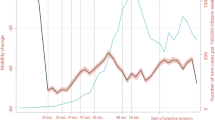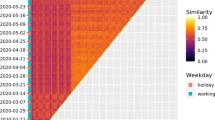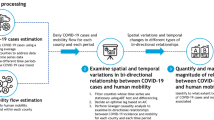Abstract
Objectives
This study has two primary research objectives: (1) to investigate the spatial clustering pattern of mobility reductions and COVID-19 cases in Toronto and their relationships with marginalized populations, and (2) to identify the most relevant socioeconomic characteristics that relate to human mobility and COVID-19 case rates in Toronto’s neighbourhoods during five distinct time periods of the pandemic.
Methods
Using a spatial-quantitative approach, we combined hot spot analyses, Pearson correlation analyses, and Wilcoxon two-sample tests to analyze datasets including COVID-19 cases, a mobile device–derived indicator measuring neighbourhood-level time away from home (i.e., mobility), and socioeconomic data from 2016 census and Ontario Marginalization Index. Temporal variations among pandemic phases were examined as well.
Results
The paper identified important spatial clustering patterns of mobility reductions and COVID-19 cases in Toronto, as well as their relationships with marginalized populations. COVID-19 hot spots were in more materially deprived neighbourhood clusters that had more essential workers and people who spent more time away from home. While the spatial pattern of clusters of COVID-19 cases and mobility shifted slightly over time, the group socioeconomic characteristics that clusters shared remained similar in all but the first time period. A series of maps and visualizations were created to highlight the dynamic spatiotemporal patterns.
Conclusion
Toronto’s neighbourhoods have experienced the COVID-19 pandemic in significantly different ways, with hot spots of COVID-19 cases occurring in more materially and racially marginalized communities that are less likely to reduce their mobility. The study provides solid evidence in a Canadian context to enhance policy making and provide a deeper understanding of the social determinants of health in Toronto during the COVID-19 pandemic.
Résumé
Objectifs
Cette étude a deux grands objectifs de recherche : 1) examiner les schémas d’agrégation spatiale des baisses de mobilité et des cas de COVID-19 à Toronto et leurs liens avec les populations marginalisées; et 2) cerner les caractéristiques socioéconomiques les plus pertinentes liées à la mobilité humaine et aux taux de cas de COVID-19 dans les quartiers de Toronto au cours de cinq périodes distinctes de la pandémie.
Méthode
À l’aide d’une approche spatio-quantitative, nous avons combiné des analyses de points chauds, des analyses de corrélation de Pearson et des tests de Wilcoxon à deux échantillons pour analyser des ensembles de données incluant : les cas de COVID-19, un indicateur dérivé d’appareils mobiles pour mesurer le temps passé à l’extérieur du domicile au niveau du quartier (c.-à-d. la mobilité), ainsi que les données socioéconomiques du recensement de 2016 et de l’indice de marginalisation ontarien. Nous avons aussi examiné les variations temporelles entre les phases de la pandémie.
Résultats
Nous avons repéré d’importants schémas d’agrégation spatiale des baisses de mobilité et des cas de COVID-19 à Toronto, ainsi que leurs liens avec les populations marginalisées. Les points chauds de la COVID-19 se trouvaient dans des grappes de quartiers plus défavorisés sur le plan matériel, où il y avait davantage de travailleurs essentiels et de personnes passant du temps à l’extérieur de leur domicile. La structure spatiale des grappes de cas de COVID-19 et de la mobilité a légèrement changé au fil du temps, mais les caractéristiques des groupes socioéconomiques communes à toutes les grappes sont restées semblables durant toutes les périodes sauf la première. Nous avons créé une série de cartes et de visualisations pour faire ressortir les schémas spatio-temporels dynamiques.
Conclusion
Les quartiers de Toronto ont vécu la pandémie de COVID-19 de façons très différentes : les points chauds des cas de COVID-19 sont survenus dans des communautés plus marginalisées sur le plan matériel et racial et moins susceptibles de réduire leur mobilité. L’étude fournit des preuves solides dans un contexte canadien pour améliorer l’élaboration des politiques et approfondir la compréhension des déterminants sociaux de la santé à Toronto pendant la pandémie de COVID-19.




Similar content being viewed by others
Availability of data and material
Ontario Marginalization data are publicly available at https://www.publichealthontario.ca/en/data-and-analysis/health-equity/ontario-marginalization-index.
Code availability
Not applicable.
References
Abbas, J., Ojo, A., & Orange, S. (2008). Geodemographics – a tool for health intelligence? Public Health, 123(1), e35–e39. https://doi.org/10.1016/j.puhe.2008.10.007
Apple. (2021). Mobility trends reports. Retrieved May 9, 2021 from https://covid19.apple.com/mobility
Awuor, L., & Melles, S. (2019). The influence of environmental and health indicators on premature mortality: An empirical analysis of the City of Toronto’s 140 neighborhoods. Health & Place, 58, 102155–102155. https://doi.org/10.1016/j.healthplace.2019.102155
Badr, H. S., Du, H., Marshall, M., Dong, E., Squire, M. M., & Gardner, L. M. (2020). Association between mobility patterns and COVID-19 transmission in the USA: A mathematical modelling study. The Lancet Infectious Diseases, 20(11), 1247–1254. https://doi.org/10.1016/S1473-3099(20)30553-3
Brzezinski, M. (2012). The Chen-Shapiro test for normality. The Stata Journal, 12(3), 368–374. https://doi.org/10.1177/1536867X1201200302
Chang, S., Pierson, E., Koh, P. W., Gerardin, J., Redbird, B., Grusky, D., & Leskovec, J. (2021). Mobility network models of COVID-19 explain inequities and inform reopening. Nature (London), 589(7840), 82–83. https://doi.org/10.1038/s41586-020-2923-3
Choi, K. H., Denice, P., Haan, M., & Zajacova, A. (2021). Studying the social determinants of COVID-19 in a data vacuum. Canadian Review of Sociology. https://doi.org/10.1111/cars.12336
City of Toronto. (2021a). Neighbourhood Profiles. Retrieved November 2, 2020 from https://www.toronto.ca/citygovernment/data-research-maps/neighbourhoods-communities/neighbourhood-profiles/
City of Toronto. (2021b). COVID-19: Status of Cases in Toronto. https://www.toronto.ca/home/covid-19/covid-19-latest-city-of-toronto-news/covid-19-status-of-cases-in-toronto/. Accessed 28 Apr 2021.
CTV News. (2020, February 27). Novel coronavirus in Canada: here’s a timeline of COVID-19 cases across the country. CTV News. Retrieved from https://www.ctvnews.ca/canada/novel-coronavirus-in-canada-here-s-a-timeline-of-covid-19-cases-across-the-country-1.4829917.
Dalton, C. M., & Thatcher, J. (2015). Inflated granularity: spatial “big data” and geodemographics. Big Data & Society, 2(2), 205395171560114. https://doi.org/10.1177/2053951715601144
Dasgupta, S., Bowen, V. B., Leidner, A., Fletcher, K., Musial, T., Rose, C., Cha, A., Kang, G., Dirlikov, E., Pevzner, E., Rose, D., Ritchey, M. D., Villanueva, J., Philip, C., Liburd, L., & Oster, A. M. (2020). Association between social vulnerability and a county's risk for becoming a COVID-19 hotspot – United States, June 1–July 25, 2020. MMWR Morb Mortal Wkly Rep, 69(42). https://doi.org/10.15585/mmwr.mm6942a3
Diez Roux, A. V., & Mair, C. (2010). Neighborhoods and health. Annals of the New York Academy of Sciences, 1186(1), 125–145. https://doi.org/10.1111/j.1749-6632.2009.05333.x
Dryhurst, S., Schneider, C. R., Kerr, J., Freeman, A. L. J., Recchia, G., van der Bles, A. M., Spiegelhalter, D., & van der Linden, S. (2020). Risk perceptions of COVID-19 around the world. Journal of Risk Research. https://doi.org/10.1080/13669877.2020.1758193
Ferguson, N.M., Laydon, D., Nedjati-Gilani, G., Imai, N., Ainslie, K., Baguelin, M., ..., & Ghani, A. C. (2020). Report 9: Impact of non-pharmaceutical interventions (NPIs) to reduce COVID-19 mortality and healthcare demand. Imperial College London, UK. COVID-19 Response Team. https://www.imperial.ac.uk/mrc-global-infectious-disease-analysis/covid-19/report-9-impact-of-npis-on-covid-19/
Flaxman, S., Mishra, S., Gandy, A., Unwin, H. J., Mellan, T. A., Coupland, H., … Bhatt, S. (2020). Estimating the effects of non-pharmaceutical interventions on COVID-19 in Europe. Nature, 584(7820), 257–261. https://doi.org/10.1038/s41586-020-2405-7.
Gatalo, O., Tseng, K., Hamilton, A., Lin, G., & Klein, E. (2021). Associations between phone mobility data and COVID-19 cases. The Lancet Infectious Diseases, 21(5), e111. https://doi.org/10.1016/S1473-3099(20)30725-8
Getis, A., & Ord, J. K. (1992). The analysis of spatial association by use of distance statistics. Geographical Analysis, 24(3), 189–206. https://doi.org/10.1111/j.1538-4632.1992.tb00261.x
Google. (2021). Google COVID-19 Community Mobility Reports. Retrieved May 9, 2021 from https://www.google.com/covid19/mobility/
Harris, R., Sleight, P., & Webber, R. (2005). Geodemographics. John Wiley.
Hawkins, R. B., Charles, E. J., & Mehaffey, J. H. (2020). Socio-economic status and COVID-19-related cases and fatalities. Public Health, 189, 129–134. https://doi.org/10.1016/j.puhe.2020.09.016
Hennerdal, P., & Nielsen, M. M. (2017). A multiscalar approach for identifying clusters and segregation patterns that avoids the modifiable areal unit problem. Annals of the American Association of Geographers, 107(3), 555–574. https://doi.org/10.1080/24694452.2016.1261685
Hotle, S., Murray-Tuite, P., & Singh, K. (2020). Influenza risk perception and travel-related health protection behavior in the US: Insights for the aftermath of the COVID-19 outbreak. Transportation Research Interdisciplinary Perspectives, 5, 100127.
Huang, X., Li, Z., Jiang, Y., Ye, X., Deng, C., Zhang, J., & Li, X. (2021). The characteristics of multi-source mobility datasets and how they reveal the luxury nature of social distancing in the U.S. during the COVID-19 pandemic. International Journal of Digital Earth, 14(4), 424–442. https://doi.org/10.1080/17538947.2021.1886358
Huang, X., Lu, J., Gao, S., Wang, S., Liu, Z., & Wei, H. (2022). Staying at home is a privilege: evidence from fine-grained mobile phone location data in the United States during the COVID-19 pandemic. Annals of the American Association of Geographers, 112(1), 286–305. https://doi.org/10.1080/24694452.2021.1904819
Jing, Q., Liu, M., Zhang, Z., Fang, L., Yuan, J., Zhang, A., … Yang, Y. (2020). Household secondary attack rate of COVID-19 and associated determinants in Guangzhou, China: a retrospective cohort study. The Lancet Infectious Diseases, 20(10), 1141–1150. https://doi.org/10.1016/s1473-3099(20)30471-0.
Kavanagh, N. M., Goel, R. R., & Venkataramani, A. S. (2020). Association of county-level socioeconomic and political characteristics with engagement in social distancing for COVID-19. MedRxiv, 2020-04.
Kolpak, P., & Wang, L. (2017). Exploring the social and neighbourhood predictors of diabetes: A comparison between Toronto and Chicago. Primary Health Care Research & Development, 18(3), 291–299. https://doi.org/10.1017/S1463423617000044
Kim, J., & Kwan, M. (2021a). The impact of the COVID-19 pandemic on people’s mobility: a longitudinal study of the U.S. from March to September of 2020. Journal of Transport Geography, 93, 103039. https://doi.org/10.1016/j.jtrangeo.2021.103039
Kim, J., & Kwan, M. (2021b). How neighborhood effect averaging might affect assessment of individual exposures to air pollution: A study of ozone exposures in Los Angeles. Annals of the American Association of Geographers, 111(1), 121–140. https://doi.org/10.1080/24694452.2020.1756208
Kimura, Y., Saito, R., Tsujimoto, Y., Ono, Y., Nakaya, T., Shobugawa, Y., … Suzuki, H. (2011). Geodemographics profiling of influenza A and B virus infections in community neighborhoods in Japan. BMC Infectious Diseases, 11(1), 36–36. https://doi.org/10.1186/1471-2334-11-36.
Kwan, M. (2012). How GIS can help address the uncertain geographic context problem in social science research. Annals of GIS, 18(4), 245–255. https://doi.org/10.1080/19475683.2012.727867
Leung, K., Wu, J. T., & Leung, G. M. (2021). Real-time tracking and prediction of COVID-19 infection using digital proxies of population mobility and mixing. Nature Communications, 12(1), 1501–1501. https://doi.org/10.1038/s41467-021-21776-2
Lou, J., Shen, X., & Niemeier, D. (2020). Are stay-at-home orders more difficult to follow for low-income groups? Journal of Transport Geography, 89, 102894–102894. https://doi.org/10.1016/j.jtrangeo.2020.102894
Madad, S., Nuzzo, J., & Bordeaux, M. (2020, December 10). The missing piece in America’s COVID-19 isolation and quarantine strategy: Wraparound services. Health Affairs Blog. Retrieved June 22, 2021 from https://www.healthaffairs.org/do/10.1377/hblog20201207.458415/full/
Maroko, A. R., Nash, D., & Pavilonis, B. T. (2020). COVID-19 and inequity: A comparative spatial analysis of New York City and Chicago hot spots. Journal of Urban Health, 97(4), 461–470. https://doi.org/10.1007/s11524-020-00468-0
Matheson, F. I., & Van Ingen, T. (2016). Ontario marginalization index: user guide. Toronto: St. Michael’s Hospital. 2018. Joint publication with Public Health Ontario.
Moin, J. S., Moineddin, R., & Upshur, R. E. G. (2018). Measuring the association between marginalization and multimorbidity in Ontario, Canada: a cross-sectional study. Journal of Comorbidity, 8(1), 2235042X18814939–2235042X18814939. https://doi.org/10.1177/2235042X18814939.
Oliver, N., Lepri, B., Sterly, H., Lambiotte, R., Deletaille, S., De Nadai, M., ... & Vinck, P. (2020). Mobile phone data for informing public health actions across the COVID-19 pandemic life cycle. Science advances, 6(23), eabc0764.
Parady, G., Taniguchi, A., & Takami, K. (2020). Travel behavior changes during the COVID-19 pandemic in Japan: Analyzing the effects of risk perception and social influence on going-out self-restriction. Transportation Research Interdisciplinary Perspectives, 7, 100181.
Price, G. N., & van Holm, E. (2020). The effect of social distancing on the spread of novel coronavirus: estimates from linked state-level infection and American Time Use Survey data. Urban Entrepreneurship and Policy Institute, University of New Orleans, New Orleans. https://doi.org/10.13140/RG.2.2.30632.32007
Rao, A., Ma, H., Moloney, G., Kwong J. C., Jüni, P., Sander, B., Kustra, R., Baral, S. D., & Mishra, S. (2021). A disproportionate epidemic: COVID-19 cases and deaths among essential workers in Toronto, Canada. Annals of Epidemiology, 63, 63–67. https://doi.org/10.1016/j.annepidem.2021.07.010.
Rey, S. J., & Anselin, L. (2007). PySAL: A Python library of spatial analytical methods. Review of Regional Studies, 37, 5–27.
Sharkey, P., & Wood, G. (2020). The causal effect of social distancing on the spread of SARS-CoV-2. https://doi.org/10.31235/osf.io/hzj7a
Squire, R. F. (2019, October 17). What about bias in the SafeGraph dataset? Retrieved May 11, 2021 from https://www.safegraph.com/blog/what-about-bias-in-the-safegraph-dataset
Strully, K., Yang, T., & Liu, H. (2021). Regional variation in COVID-19 disparities: Connections with immigrant and Latinx communities in U.S. counties. Annals of Epidemiology, 53, 56–62.e2. https://doi.org/10.1016/j.annepidem.2020.08.016
Sundaram, M. E., Calzavara, A., Mishra, S., Kustra, R., Chan, A. K., Hamilton, M. A., … Kwong, J. C. (2020). The individual and social determinants of COVID-19 diagnosis in Ontario, Canada: a population-wide study. medRxiv. https://doi.org/10.1101/2020.11.09.20223792.
Sung, B. (2021). A spatial analysis of the effect of neighborhood contexts on cumulative number of confirmed cases of COVID-19 in U.S. counties through October 20 2020. Preventive Medicine, 147, 106457–106457. https://doi.org/10.1016/j.ypmed.2021.106457
Tammes, P. (2020). Social distancing, population density, and spread of COVID-19 in England: a longitudinal study. BJGP Open, 4(3). https://doi.org/10.3399/bjgpopen20X101116
Tizzoni, M., Bajardi, P., Decuyper, A., Kon Kam King, G., Schneider, C. M., Blondel, V., …, Colizza, V. (2014). On the use of human mobility proxies for modeling epidemics. PLoS Computational Biology, 10(7), e1003716. https://doi.org/10.1371/journal.pcbi.1003716.
Vegvari, C., Abbott, S., Ball, F., Brooks-Pollock, E., Challen, R., Collyer, B. S., ... & Trapman, P. (2022). Commentary on the use of the reproduction number R during the COVID-19 pandemic. Statistical Methods in Medical Research, 31(9), 1675–1685.
Veraset. (2021). About - Veraset. Retrieved April 7, 2021 from https://www.veraset.com/about/
Vollmer, M. A., Mishra, S., Unwin, H. J. T., Gandy, A., Mellan, T. A., Bradley, V., ... & Bhatt, S. (2020). Report 20: Using mobility to estimate the transmission intensity of COVID-19 in Italy: A subnational analysis with future scenarios. MedRxiv, 2020-05.
Wang, L. (2014). Immigrant health, socioeconomic factors and residential neighbourhood characteristics: A comparison of multiple ethnic groups in Canada. Applied Geography (Sevenoaks), 51, 90–98. https://doi.org/10.1016/j.apgeog.2014.03.010
Wang, L., & Hu, W. (2013). Immigrant health, place effect and regional disparities in Canada. Social Science & Medicine, 98, 8–17. https://doi.org/10.1016/j.socscimed.2013.08.040
Wang, L., & Ramroop, S. (2018). Geographic disparities in accessing community pharmacies among vulnerable populations in the Greater Toronto Area. Canadian Journal of Public Health, 109, 821–832.
Wang, L., Yu, J., Chen, D., & Yang, L. (2021). Relationships among COVID-19 prevention practices, risk perception and individual characteristics: A temporal analysis. International Journal of Environmental Research and Public Health, 18, 10901. https://doi.org/10.3390/ijerph182010901
Watts, A., Au, N. H., Thomas-Bachli, A., Forsyth, J., Mayah, O., Popescu, S., & Bogoch, I. I. (2020). Potential for inter-state spread of Covid-19 from Arizona, USA: analysis of mobile device location and commercial flight data. Journal of Travel Medicine, 27(8), taaa136
Winskill, P., Whittaker, C., Walker, P., Watson, O., Laydon, D., Imai, N., Cuomo-Dannenburg, G., …, Ghani, A. (2020). Report 22: Equity in response to the COVID-19 pandemic: an assessment of the direct and indirect impacts on disadvantaged and vulnerable populations in low- and lower middle-income countries. COVID-19 Response Team, Imperial College. https://www.imperial.ac.uk/mrc-global-infectious-disease-analysis/covid-19/report-22-equity/
Zygmunt, A., Tanuseputro, P., James, P., Lima, I., Tuna, M., & Kendall, C. E. (2020). Neighbourhood-level marginalization and avoidable mortality in Ontario, Canada: a population-based study. Canadian Journal of Public Health, 111(2), 169–181. https://doi.org/10.17269/s41997-019-00270-9.
Acknowledgements
The authors would like to thank the two anonymous reviewers whose insightful and critical comments greatly improved the paper. Support from CIHR Operating Grant: Canadian 2019 Novel Coronavirus (COVID-19) Rapid Research Funding Opportunity (grant number OV7-170378) is gratefully acknowledged. The paper included materials from a graduate Major Research Paper –Forsyth, Jack. 2021. Spatiotemporal sociodemographic analysis of covid-19 case rates and mobility in Toronto neighbourhoods, Master of Spatial Analysis, Toronto Metropolitan University (formerly Ryerson University).
Funding
Not applicable.
Author information
Authors and Affiliations
Contributions
Forsyth: Developing the topic, conducting the literature review, data cleaning and analysis and writing of the paper. Wang: Developing the topic, providing guidance in all stages and aspects of the study, revising the paper. Thomas-Bachli: Providing helpful insights and advice on the topic, data analysis and interpretation. All the authors read and approved the final manuscript for publication.
Corresponding author
Ethics declarations
Conflict of interest
The authors declare no competing interests.
Ethics approval
Not applicable (no primary data were used)
Consent to participate
Not applicable.
Consent for publication
Not applicable.
Additional information
Publisher's Note
Springer Nature remains neutral with regard to jurisdictional claims in published maps and institutional affiliations.
Appendix
Appendix
Table 5
Rights and permissions
Springer Nature or its licensor (e.g. a society or other partner) holds exclusive rights to this article under a publishing agreement with the author(s) or other rightsholder(s); author self-archiving of the accepted manuscript version of this article is solely governed by the terms of such publishing agreement and applicable law.
About this article
Cite this article
Forsyth, J., Wang, L. & Thomas-Bachli, A. COVID-19 case rates, spatial mobility, and neighbourhood socioeconomic characteristics in Toronto: a spatial–temporal analysis. Can J Public Health 114, 806–822 (2023). https://doi.org/10.17269/s41997-023-00791-4
Received:
Accepted:
Published:
Issue Date:
DOI: https://doi.org/10.17269/s41997-023-00791-4




